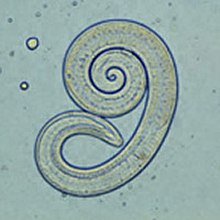
Back دودة شعرية Arabic دوده شعريه ARZ Trichinella Catalan Trichinen German Trichinella Spanish Keeritsuss Estonian Trichinella French Tricíne Irish Trikino IO Tríkínur Icelandic
This article needs additional citations for verification. (August 2010) |
| Trichinella | |
|---|---|

| |
| Scientific classification | |
| Domain: | Eukaryota |
| Kingdom: | Animalia |
| Phylum: | Nematoda |
| Class: | Enoplea |
| Order: | Trichocephalida |
| Family: | Trichinellidae |
| Genus: | Trichinella Railliet, 1895 |
| Species | |
|
Trichinella britovi | |
Trichinella is the genus of parasitic roundworms of the phylum Nematoda that cause trichinosis (also known as trichinellosis). Members of this genus are often called trichinella or trichina worms. A characteristic of Nematoda is the one-way digestive tract, with a pseudocoelom (body cavity made up of only an ectoderm and endoderm).
The genus was first recognised in a larval form in 1835. The L1 larvae live in a modified skeletal muscle cell. The adult worms occupy a membrane-bound portion of columnar epithelium, living as intramulticellular parasites of animals, including humans. Infections with this genus have been reported from more than 150 different naturally or experimentally infected hosts. It has been shown to have a worldwide distribution in domestic and/or sylvatic animals.
Trichinella is the smallest human nematode parasite, yet it is also the largest of all intracellular parasites.
Oral ingestion of cyst- or larvae-contaminated tissue is the usual route of infection, but congenital and mammary transmission can occur in rats.[1]
- ^ Matenga, Elizabeth; Mukaratirwa, Samson; Bhebhe, Evison; Willingham, Arve Lee (2006). "Evidence of congenital and transmammary transmission of Trichinella zimbabwensis in rats (Rattus norvegicus) and its epidemiological implications" (PDF). Intern J Appl Res Vet Med. 4 (4). Archived (PDF) from the original on 2019-07-08. Retrieved 2011-06-30.
© MMXXIII Rich X Search. We shall prevail. All rights reserved. Rich X Search